This was published 5 years ago
Five obscure locations made popular - and forever ruined - by Instagram
By Greg Dickinson
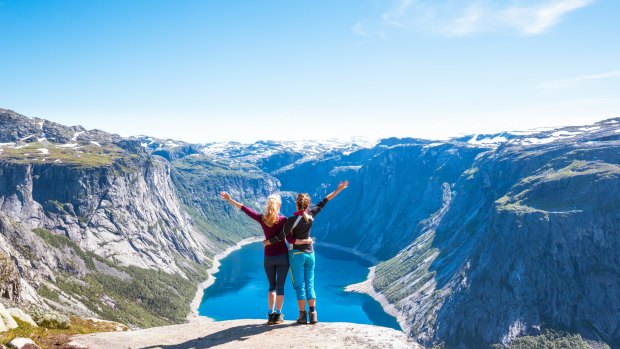
Trolltunga had had an astronomical rise in popularity since the release of Instagram in 2010. Credit: SHUTTERSTOCK
Back in 2009, fewer than 1,000 people made the ten-hour trek up to a remote viewpoint in southeastern Norway, known to locals as 'Trolltunga' (literally, 'troll's tongue'). There were no queues, no hashtags. 4G did not exist yet and, even if it did, you wouldn't be able to access it in this remote part of the world.
It was just a beautiful view, overlooking a lake.
Around the same time, two young ex-Google employees were putting the finishing touches to a location-recommendation app called 'Burbn'. They would later refine the product to focus on photo sharing and rename it 'Instagram'.
Ten years later, that tech startup has over 800 million users, tens of thousands of whom visited Trolltunga last year to capture a photograph on their mobile phone to post on Instagram. It is no exaggeration to say the app has shifted the tectonics of how many people, particularly millennials, see the world.
A reality check – many of the world's most Instagrammed destinations were already on the map before the app launched. The Eiffel Tower, Central Park and Iceland's Blue Lagoon (all up there with the most 'grammed' sights) aren't exactly newcomers on the tourist trail. But there are a handful of sights, such as Trolltunga, that have had an astronomical rise in popularity since the release of Instagram in 2010.
Some argue that this isn't a good thing. Commenting on the rise of Instagram, Justin Francis of Responsible Travel told Telegraph Travel: "A great photo should be the result of a wonderful experience, not the reason to go. Travel is changing. It's becoming more about building personal brands through social media than about seeking experiences that enrich people's lives and understanding themselves and the world. The desire to capture the same iconic shot as your favourite celebrity or influencer is also contributing to overtourism, which makes places less enjoyable for residents as well as other travellers."
Here we take a look at five photogenic destinations that, for better or for worse, Instagram put on the map.
Trolltunga, Norway
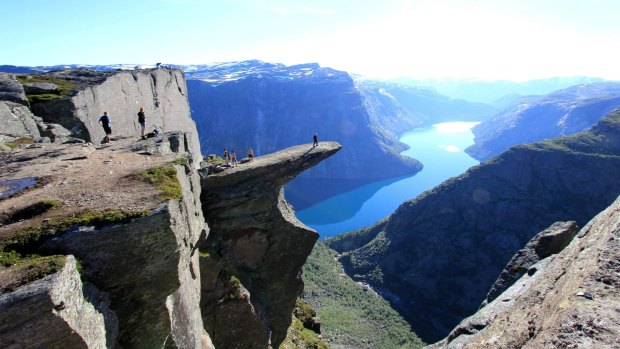
Credit: Steinar Talmoen
The extraordinary Trolltunga verge formed during the Ice Age around 10,000 years ago, but it has only found fame in the last ten.
At the time of writing, 118,837 people had tagged an Instagram post with #trolltunga – typically a shot of themselves with arms outstretched, perhaps looking meaningfully over Lake Ringedalsvatnet or, as pictured below, something a bit more extreme like doing a backflip.
There is, however, a reality to getting that snap.
"Many don't realise that the walk to the rock is a really tough route, taking up to 10 hours up and down, and are taken aback at just how difficult a climb it is," said The Telegraph's Meabh Ritchie. "I met two Americans who were incredulous about the lack of toilets en route and were calling for a road right to the top. Others were annoyed at the lack of 3G delaying their social media posting."
"Once you reach the top, climbers queue for their chance to take a photo on the spectacular plateau," added Ritchie. "Despite the wind, and the narrow ledge, groups of people were jumping in the air, sitting with their legs dangling over the edge and, of course – taking selfies."
The rise of interest can be seen clearly by analysing the Google Trends graph of searches for 'trolltunga' since 2004.
Swimming pigs, The Bahamas
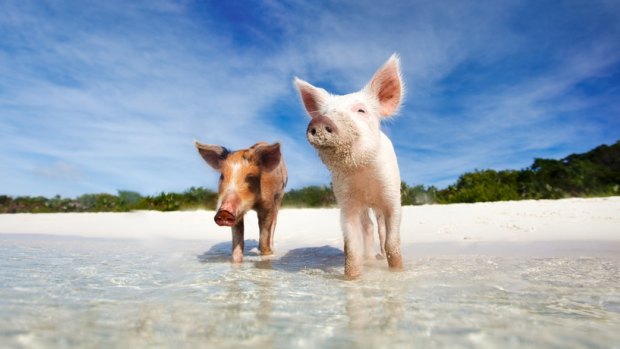
Credit: Shutterstock
If the lure of white sand beaches and turquoise waters isn't enough to tempt you to Big Major Cay, an uninhabited sliver of the Exuma archipelago in The Bahamas, then perhaps the notion of swimming with pigs will be.
The beach has become famous for its porcine residents, wallowing in the shallows. They have, however, become a victim of their own cuteness. In 2017, several of the pigs were found dead and the man who started the colony says tourists are to blame.
Wayde Nixon, who claims to have created the colony 30 years ago, suggests visitors are at fault for feeding the animals. He told The Nassau Guardian that the pigs are now too big an attraction and that tourism is getting out of control.
"Right now it's blowing out of proportion," he said, "with people, anybody bringing food there, anybody doing what they [want to] do. We have people coming there giving the pigs beer, rum, riding on top of them, all kind of stuff. That never happened, but lately [it has] because it's so big."
There are only said to be between ten and 15 of the pigs remaining, although interest in the beach is showing no sign of slowing down. The hashtag #exuma has been used 118,000 times and #swimmingpigs is used on over 69,000 posts.
The Google Trends graph below highlights the steep rise in popularity of the beach since Instagram launched in 2010.
Giraffe Manor, Kenya
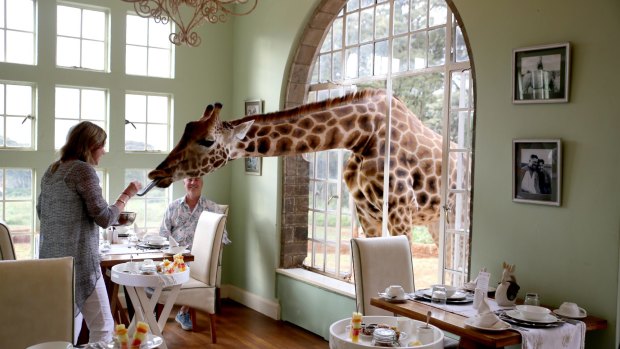
Credit: Ben Groundwater
This 1930s, Scottish-style manor house built in the outskirts of Nairobi is famous for its friendly neighbours – a herd of Rothschild giraffes that have the habit of sticking their long necks through windows to be fed treats.
Describing the experience, Sasha Slater wrote: "The highlight of the Manor is the inhabitants. There's a giraffe reserve next door and, when that closes for the day, the endangered Rothschild giraffes it houses saunter over to the Manor's terrace, accompanied by their faithful warthog companions. Here the Manor's guests feed the giraffes horse nuts, which they scoop up with their long inky blue tongues. You, meanwhile, have the most civilised of cream teas – finger sandwiches, scones and all – out of Royal Albert bone-china cups.
"The giraffes will poke their heads through the windows of the restaurant at breakfast time too, in the hopes of a treat as you eat your full English. Their fur feels rough to the touch and their eyelashes are inches long and thick as wire."
There are no signs that the Insta-fame of these giraffes has negatively impacted the visitor experience at the manor, although photos of the giraffes poking their heads through the windows have become a common sight on the platform. Over 30,000 posts have been labelled #giraffemanor, and celebrities including Ellen DeGeneres, Ellie Goulding and Richard Branson have visited in recent years. Perhaps Giraffe Manor will go down as an example of a once-unique experience that became normalised by social media.
The Google Trends chart shows a spike in interest since 2010, with a particular boom in the last five years.
Fairy Pools, Isle of Skye
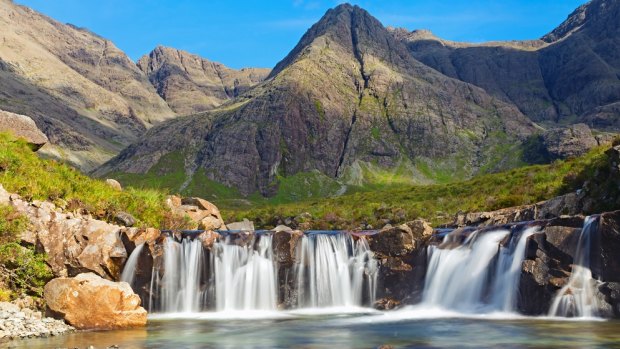
Credit: Shutterstock
It's locally known as the Allt Coir' a' Mhadaidh, although since this series of waterfalls in Skye was rebranded the Fairy Pools, and a hashtag was plonked in front of it, it has become one of the most popular sights in Scotland. Tourist arrivals across Skye increased by 13 per cent between 2014 and 2016; during the same time visits to the Fairy Pools went up by 54 per cent.
"In the last four years the number of tourists coming here has really, really boomed," says Henrik Micski, part of the Minginish community group working on a project to expand the car park at the Fairy Pools. "On a rainy day we'll still get around a thousand people at the Fairy Pools. In some respects it's too crowded, with regards to the number of cars parked on the side of the road. It's at a point where the crowds need to be managed."
"People who live in the village down the road from the Fairy Pools have to plan how they're going to get to work. Sometimes fire trucks can't get past, which has a knock-on effect. It needs to be managed, which we're trying to do by building this new car park.
"There are a lot of people who arrive with unsuitable footwear. Just a little bit of extra research and better planning is needed when people are coming here on holiday. I think people need to be a little bit more prepared because the image that you see on social media isn't necessarily the true picture."
The rise of interest surrounding the Fairy Pools is clear on the Google Trends chart, below, which shows a boom in searches since Instagram launched in 2010. Despite the hype, the Skye tourism organisation Skye Connect published an unprecedented open letter last summer saying that it is open for business.
Sólheimasandur, Iceland

Credit: Shutterstock
The Instagram Effect does not only apply to destinations receiving tens of thousands of visitors – it can also have an impact on a more micro scale.
The Sólheimasandur plane wreck in Iceland is an example of this. The US Navy Douglas Dakota DC 3 came down in November 1973 and the wreck remains on a beach not far from the village of Vik in South Iceland.
Since the rise of Instagram, Sólheimasandur has become an increasingly popular destination, an example of the rising trend of people seeking out 'ruin porn' and sharing their images of abandoned sights on the platform.
While Instagram is partly to thank for the rise of interest in the wreckage, its popularity was exarcebated after it appeared in Justin Bieber's music video for the song I'll Show You. It has also appeared in a Bollywood movie, several TV advertisements and a 2007 Sigur Rós documentary.
In a recent Instagram post, user @yeoyeo86 wrote: "Getting photos here without people standing, hanging or climbing over the plane was difficult, but I managed to capture a couple in the sun highlighting the scale."
The wreck became so popular that, in 2016, the landowners decided to close the road leading to the sight. Farmer Benedikt Bragason told IcelandMag the decision was made because visitor behaviour in the area was not acceptable. As a result, people now need to walk for two miles from a car park. Local authorities warn that tourists must go prepared, and not attempt the walk during winter: in October 2017 a young American tourist died of exposure near the plane wreck.
The Telegraph, London
See also: Overrun by tourists: Countries with worst 'overtourism' named
See also: How to avoid annoying locals in the 10 cities most overrun by tourists
Sign up for the Traveller newsletter
The latest travel news, tips and inspiration delivered to your inbox. Sign up now.